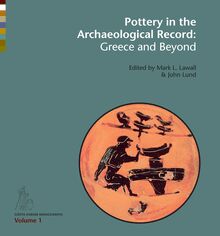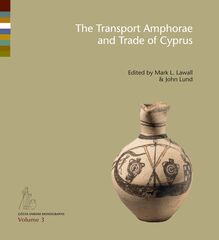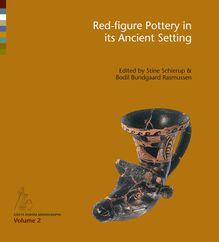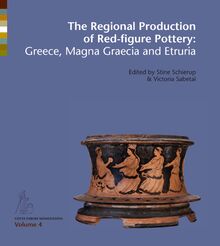-
 Univers
Univers
-
 Ebooks
Ebooks
-
 Livres audio
Livres audio
-
 Presse
Presse
-
 Podcasts
Podcasts
-
 BD
BD
-
 Documents
Documents
-
- Cours
- Révisions
- Ressources pédagogiques
- Sciences de l’éducation
- Manuels scolaires
- Langues
- Travaux de classe
- Annales de BEP
- Etudes supérieures
- Maternelle et primaire
- Fiches de lecture
- Orientation scolaire
- Méthodologie
- Corrigés de devoir
- Annales d’examens et concours
- Annales du bac
- Annales du brevet
- Rapports de stage
La lecture à portée de main
392 pages
English
Découvre YouScribe en t'inscrivant gratuitement
Je m'inscrisA Study of the Circulation of Ceramics in Cyprus from the 3rd Century BC to the 3rd Century AD , livre ebook
Découvre YouScribe en t'inscrivant gratuitement
Je m'inscris
Obtenez un accès à la bibliothèque pour le consulter en ligne
En savoir plus
En savoir plus
392 pages
English
Obtenez un accès à la bibliothèque pour le consulter en ligne
En savoir plus
En savoir plus

Description
This is the first monograph devoted solely to the ceramics of Cyprus in the Hellenistic and Roman Periods. The island was by then no longer divided into kingdoms but unified politically, first under Ptolemaic Egypt and later as a province in the Roman Empire. Submission to foreign rule was previously thought to have diluted - if not obliterated - the time-honoured distinctive Cypriot character. The ceramic evidence suggests otherwise.
The distribution of local and imported pottery in Cyprus points to the existence of several regional exchange networks, a division that also seems reflected by other evidence. The similarities in material culture, exchange patterns and preferential practices are suggestive of a certain level of regional collective self-awareness.
From the 1st century BC onwards, Cyprus became increasingly engulfed by mass produced and standardized ceramic fine wares, which seem ultimately to have put many of the indigenous makers of similar products out of business - or forced them to modify their output. Also, the ceramic record gradually became less diverse during the Roman Period than before - developments which we today might be inclined to view as symptoms of an early form of globalisation.
The distribution of local and imported pottery in Cyprus points to the existence of several regional exchange networks, a division that also seems reflected by other evidence. The similarities in material culture, exchange patterns and preferential practices are suggestive of a certain level of regional collective self-awareness.
From the 1st century BC onwards, Cyprus became increasingly engulfed by mass produced and standardized ceramic fine wares, which seem ultimately to have put many of the indigenous makers of similar products out of business - or forced them to modify their output. Also, the ceramic record gradually became less diverse during the Roman Period than before - developments which we today might be inclined to view as symptoms of an early form of globalisation.
Sujets
Informations
| Publié par | Aarhus University Press |
| Date de parution | 26 octobre 2015 |
| Nombre de lectures | 0 |
| EAN13 | 9788771244519 |
| Langue | English |
| Poids de l'ouvrage | 50 Mo |
Informations légales : prix de location à la page 0,1950€. Cette information est donnée uniquement à titre indicatif conformément à la législation en vigueur.
Extrait
A Study of the Circulation of Ceramics in Cyprus from the 3rd Century BC to the 3rd Century AD
John Lund
Aarhus University Press
A STUDY OF THE CIRCULATION OF CERAMICS IN CYPRUS FROM THE 3RD CENTURY BC TO THE 3RD CENTURY AD © Aarhus University Press and the author 2015 GÖSTA ENBOM MONOGRAPHS General editor: Bodil Bundgaard Rasmussen Editorial board: Mark L. Lawall, John Lund, Dyfri Williams Published with support from The Foundation of Consul General Gösta Enbom
Amphora attributed to the painter Syriskos, Athens 500 470 BC, Collection of Classical and Near Eastern Antiquities, The National Museum of Denmark, i.n. Chr. VIII 320.
Graphic design: Nina Grut, MDD Ebook production by Narayana Press Typeset with Stone Serif and Stone Sans ISBN 978 87 7124 394 9 ISSN 19046219 Aarhus University Press Langelandsgade 177 DK8200 Aarhus N White Cross Mills Lancaster LA1 4XS, England 70 Enterprise Drive, suite 2 Bristol, CT 06010, USA www.unipress.dk Front cover: A head vase allegedly from Cyprus in the National Museum of Denmark, Collection of Classical and Near Eastern Antiquities, i.n. 1035. Photo: John Lee Weblinks were active when the book was printed. They may no longer be active.
Table of Contents
7Preface The Author's Acknowledgements
11Chapter 1 Introduction Aim Primary and Secondary Material The Presentation of the Evidence The Geographical Framework The Chronological Range Point of Departure
19Chapter 2 Hellenistic and Roman Cyprus: An Overview The Hellenistic Period Historical Synopsis Archaeological Overview The Roman Period Historical Synopsis Archaeological Overview
33Chapter 3 Prolegomena Ceramic Terminology and Taxonomy Chronological Issues The Hellenistic and Roman Pottery of Cyprus: Stand Der Forschung Pottery from Excavations Pottery from Surveys Pottery from Underwater Explorations Studies of Specific Wares and Forms The Emergence of a Regional Approach
43Chapter 4 A Regional Approach Definitions Methodlogy Mapping Distributions The Spatial Distribution The Chronological Distribution Challenges
49Chapter 5 Evidence for Kilns and Potters in Cyprus, c. 300 BC to AD 300 The Raw Materials Clay Water Fuel The Workshops Kilns Potter’s Tools Misfired Pottery Inscriptions Naming Potters The Sanctuary of the Nymph at Kafizin Other Epigraphic Evidence Representations of Potters Engendering the Potters The Location of the Workshops Modes of Production
57Chapter 6 Scientific Clay Analyses of Hellenistic and Roman Pottery from Cyprus Nea Paphos Nea Paphos, Amathous and Kition The Akamas Skouriotissa MaroniPetrera, Nea Paphos, Diorios, Athienou and Marina ElAlamein Idalion Ledri, The Hill of Agios Georgios and Kafizin Israel Jordan Alexandria Interpretative Challenges
63Chapter 7 Case Studies I. PalmLeaf Ware II. Lagynoi III. West Slope Pottery IV. Colourcoated Ware IV.A The Kantharos with Two Vertical Looped Handles IV.B The Tall Skyphos with Carinated Body and Lateral
A S T U D Y O F T H E C I R C U L A T I O N O F P O T T E R Y I N C Y P R U S F R O M T H E 3 R D C E N T U R Y B C T O T H E 3 R D C E N T U R Y A D
153
Arched Handles IV.C The Aradippou Goblet IV.D The Mastoid Bowl IV.E Mouldmade Bowls and Derivatives V. “Pink Powdery Ware” VI. Matt Red Ware VII. “Cruches Locales” VIII. Jugs With Gouged Decoration IX. Clay Lanterns X. Conical Unguentaria XI. The Frying Pan with Folded Handle XII. The Skouriotissa Type Transport Amphora XIII. Head Vases of the Magenta Group XIV. Rattles in the Shape of a Pig XV. Askoi in the Shape of Various Animals
Chapter 8 Beyond Distribution Patterns Western Cyprus Northwestern Cyprus Northeastern Cyprus Northeastern and Eastern Cyprus Eastern Cyprus Southern Cyprus Southern and Central Cyprus Central Cyprus Ceramic Regions Making Sense of the Ceramic Regions Approaching the Centres of Production Regional Exchange Systems Modes of Exchange
163Chapter 9 Cyprus and her Closest Neighbours: A Ceramic Perspective Fine Wares Eastern Sigillata A Cypriot Sigillata (Eastern Sigillata D) Lead Glazed Vessels from Tarsus Coarse Wares The Pinchedhandle Amphorae Agora M 54 Amphorae Clay Sarcophagi
185
Western Rough Cilicia and Western Cyprus Eastern Rough Cilicia and Cyprus Northwestern Syria and Eastern Cyprus Implications
Chapter 10 Longdistance Exchanges Involving Cyprus Imports from Italy Gnathia Pottery Campana A Ware Campana B Ware Italian Type Sigillata Thinwalled Pottery Bailey Leadglazed Ware Pompeian Red Ware and Other Italian Cooking Wares Imports from Greece, the Aegean and the Black Sea Region Attic and Pergamene West Slope; the Ivy Platter Workshop Hadra Vases Sinopean Transport Amphorae Rhodian Transport Amphorae Rhodian Lagynoi Knidian Fine Ware Knidian Relief Ware A Propontic Jug with Barbotine Ornament Thinwalled Mugs from the Thracian Coast (?) Terracotta Lamps of the Romanensis Workshop in Knidos or Miletus Corinthian Relief Ware Monopodia from Prokonnesos Imports from Southern Asia Minor? Domedmouth Unguentaria Imports from the SouthEast Semifine Amphoriskoi from Tyre Beirut Amphorae Mouldmade Glass Signed by ENNION Nabataean pottery Pinctada Margaritifera from the Red Sea Imports from Egypt Faience Vessels Ivories and Bone Egyptian Ceramic Fine Wares Egyptian Cooking Wares Egyptian Transport Amphorae
211
223
229
Ptolemaic Terracotta Lamps Imports from Tunisia African Red Slip Ware The geographical distribution of these imports Cypriot Ceramic Exports Sea Routes And Flows Of Goods Through Time The Hellenistic Period The Roman Period
Chapter 11 Writing Economic History with Potsherds? Ancient Economies: Some Current Theories Pottery as Proxy A Ceramic Perspective Standardisation Mass Production and Export of Fine Wares Connectivity The View from Cyprus Was Cyprus an Integrated Market for Ceramics? A Process of Simplification Fiercely Competing Fine Wares: Imports vs. Local Products Export of Cypriot Amphoraborne Commodities
Chapter 12 From the Producer to the Consumer Craftsmen and Traders Transport Wholesale and Retail The Consumer
Chapter 13 The Regionality of Hellenistic and Roman Cyprus Western Cyprus The Cult of Opaon Melanthios The Custom of Duplication Stamp seals of Geronisos Terracotta Figurines Eastern Cyprus Terracotta Figurines Southeastern Cyprus Limestone Sculptures Limestone Cippi
237
247
305
Southern Cyprus The Cult of Theos Hypsistos Terracotta Figurines Limestone Cippi Central Cyprus Limestone Sculptures Anatomical Exvotos Votive Figurines Showing a Woman Giving Birth Limestone Cippi What does it all mean? Ethnicity? Politics? Identity? Regionality
Chapter 14 Conclusions The Hellenistic Period Continuity Change and Expansion Pottery Production Pottery Distribution The Roman Period Continuity Roman Settlers Challenges to the Ceramic Industry Pottery Circulation: a New Complexity From Ceramic to Archaeological Regions Regionality in Cyprus: A Diachronic Perspective Economy Matters An Integrated Market? Interregional Networks Imperial Bazaar? Sic Transit … Settlement Contraction and Abandonment Widening the Field of Vision Why? Epilogue
Catalogue
Bibliography
T A B L E O F C O N T E N T S
Preface
P E R K R I S T I A N M A D S E N D I R E C T O R G E N E R A L T H E N A T I O N A L M U S E U M O F D E N M A R K M E M B E R O F T H E B O A R D O F T H E F O U N D A T I O N O F C O N S U L G E N E R A L G Ö S T A E N B O M
Gösta Enbom figures prominently in the title of this monograph series, but his is hardly a household name, so it seems appropriate to begin with a brief sketch of the life of this remarkable man. Born in Sweden in 1895, Enbom went as a delegate of the Swedish Red Cross to Athens during World War II, where his humanitarian efforts helped alleviate the cruel famine of 1942. Enbom stayed in Greece after the end of the War and eventually made his fortune as agent in Piraeus of the Danish firm Burmeister & Wain which was renowned at the time for its highly effective ships engines that were widely used in Greece. He was appointed Royal Danish Consul in 1952 – serving from 19671975 as Consul General – and began in the 1970’s to support the Swedish excavations at Asine in the Argolid financially. He later established his Danish Foundation to fund archaeological research carried out in the Mediterranean by the National Museum of Denmark. Since Enbom’s death in 1986, his foundation has been instrumental in sponsoring Danish archaeological field projects in Greece and Danish classical archaeological research in general. In 2008, the National Museum of Denmark launched a research programme entitled “Pots, Potters and Society in Ancient Greece” thanks to generous support by the Foundation of Consul General Gösta Enbom. The results of this initiative have been published annually since 2011 in the new series entitled Gösta Enbom Monographs, of which this is number five. The first four volumes were anthologies with contributions by specialists from a wide range of nations. The present publication, which focuses on the ceramics of the Island of Cyprus between c. 300 BC and AD 300, was written by a single author, John Lund, who deserves much appreciation for his work. It is the first monograph to appear which has been devoted solely to the pottery of Cyprus during these centuries, when the island
Consul General Gösta Enbom (18951986).
was unified politically, albeit under foreign rule – first as a part of the Ptolemaic Kingdom of Egypt and later as a province in the Roman Empire. This volume marks the conclusion of “Pots, Potters and Society in Ancient Greece”, and I take the opportunity to extend my warmest thanks to the Foundation of Consul General Gösta Enbom and indeed to all who have participated in this research programme and have contributed to its success. The National Museum will con tinue its archaeological research of ancient Greece, which plays a prominent part in our museum’s exhibition galleries devoted to the ancient cultures of the Mediterranean.
This page is protected bycopyright and maynot be redistributed.
P R E F A C E
7
A S T U D Y O F T H E C I R C U L A T I O N O F P O T T E R Y I N C Y P R U S F R O M T H E 3 R D C E N T U R Y B C T O T H E 3 R D C E N T U R Y A D
8
THE AUTHOR’S ACKNOWLEDGEMENTS I wish to begin by expressing my sincere gratitude to those responsible for my involvement in Cypriot archaeology in the first place. Vassos Karegeorghis introduced me to the subject in June 1974, when I came to Larnaka with a group of students from the University of Copenhagen to take 1 part in his excavations at Kition. I am no less grateful to Lone Wriedt Sørensen and David W. Rupp, who directed the Canadian Palaipaphos Survey Project (CPSP) in the area of Kouklia in Western Cyprus and invited me to publish the ceramic fine wares from this project in 1984. Then, in 1993, Lone asked me to do the same for her excavations at Panagia EmathousaAradippou, and two years later Jane Fejfer entrusted me with the publication of the pottery from the Danish survey and excavations on the Akamas peninsula in Western Cyprus. This monograph was written within the framework of the research programme ‘Pots, Potters and Society in Ancient Greece’, hosted by the Museum of Denmark, thanks to a substantial grant from the Foundation of 2 Consul General Gösta Enbom. I wish to express my warmest thanks and appreciation to the Foundation for having funded my research in Cyprus, Greece and Turkey and for providing the generous financial support that made this publication possible. I benefitted from the hospitality of The Cyprus American Archaeological Research Institute in Nicosia (CAARI) and from the assistance of Vathoulla Moustoukki. The librarians at the Nordic Library at Athens, Vibeke Espholm Kourtovik and Evi Charitoudi, were also most helpful. I owe a huge debt of gratitude to many colleagues and friends outside Denmark, who were always willing to answer my queries, discuss common interests, send offprints, allow me to reproduce figures from their publications and supply me with illustrations. Thanks are especially due to Jeroen Poblome and Daniele Malfitana, whose personal friendship and professional capabilities are highly appreciated. Everyone I have been in touch with has been extraordinarily helpful, but I am particularly indebted to Thomas Kiely for patiently answering my seemingly neverending questions about objects in the British Museum – and for helping me obtain photos of many of them. Thanks also to Allison Akbay, Catherine AbadieReynal, Françoise Alabe, Pascal Arnaud, Craig Barker, Martin Benz, Philip Bes, Andrea M. Berlin, Sylvia Brehme, Ben Costello IV, John K. Davies, Stella Demesticha,
Anne DestrooperGeorgiades, Agata Dobosz, Arnold H. Enklaar, Rune Frederiksen, Jörg Gebauer, the late Wilfred Geominy, Richard Green, Joseph A. Greene, Alix Hänsel, Sophokles Hadjissavas, Eleni Hasaki, John W. Hayes, John H. Humphrey, Alan Johnston Anthi Kaldeli, Ove Kaneberg, Mark L. Lawall, Justin Leitwanger, John R. Leonard, Franz G. Maier, Sandrine Marquié, Harmut Matthäus, Joan R. Mertens, Henryk Meyza, Jolanta Młynarczyk, Anne Marie Nielsen, Ewdoxia PapuciWładyka, Nicholas K. Rauh, Paul Reynolds, Cristine Rogl, Renate RosenthalHeginbottom, Susan I. Rotroff, JeanFrançois Salles, AnnLouise Schallin, Walter Scheidel, KaanŞenol, Peter J. Stone, Roberta Tomber, Anja Ulbrich, Yona Waksman, Jennifer Webb, Rinse Willet, David F. Williams and Lina Ålenius. I owe a vote of thanks, also, to Danish friends and colleagues. To Lise Hannestad, who originally encouraged me to embark on the present monograph, and to my “ceramic fellow travellers”: Kristina WintherJacobsen, Søren Handberg, Jakob Munk Højte, and Leif Erik Vaag, with whom I have had many fruitful discussions. I am no less thankful to Tønnes BekkerNielsen for his readiness in offering expert advice on the geography and roads of Cyprus, and to Vincent Gabrielsen for setting me straight on some issues related to ancient history. Closer to home, I am most grateful for the trust in me shown by the current Director of the National Museum, Per Kristian Madsen, and his predecessor, Carsten U. Larsen. However, the volume would not have seen the light of day without the constant support and encouragement of Bodil Bundgaard Rasmussen, Head of Research and Collections, Ancient Cultures of Denmark and the Mediterranean. My daily interaction with my colleagues in the National Museum, in particular Anne Haslund Hansen, Sanne Hoffmann, Stine Schierup, Peter Pentz, Flemming Kaul and Peter Vang Petersen, made the process of writing enjoyable, even if I am sure that they often wondered what all the fuss was about. Stephen Lumsden, who undertook to correct my English, provided much sound advice and saved me from innumerable mistakes. The remaining errors and other shortcomings are of course entirely of my own doing. The graphic designer Nina Grut was responsible for the excellent layout of the present publication – as with the other volumes in the Gösta Enbom Monograph Series. Martin Bassett meticulously prepared the maps, and Freerk Oldenburger redrew the figures, cleaned up the photos, and made sure that all objects illustrated are to the scale
This page is protected bycopyright and maynot be redistributed.
-
 Univers
Univers
-
 Ebooks
Ebooks
-
 Livres audio
Livres audio
-
 Presse
Presse
-
 Podcasts
Podcasts
-
 BD
BD
-
 Documents
Documents
-
Jeunesse
-
Littérature
-
Ressources professionnelles
-
Santé et bien-être
-
Savoirs
-
Education
-
Loisirs et hobbies
-
Art, musique et cinéma
-
Actualité et débat de société
-
Jeunesse
-
Littérature
-
Ressources professionnelles
-
Santé et bien-être
-
Savoirs
-
Education
-
Loisirs et hobbies
-
Art, musique et cinéma
-
Actualité et débat de société
-
Actualités
-
Lifestyle
-
Presse jeunesse
-
Presse professionnelle
-
Pratique
-
Presse sportive
-
Presse internationale
-
Culture & Médias
-
Action et Aventures
-
Science-fiction et Fantasy
-
Société
-
Jeunesse
-
Littérature
-
Ressources professionnelles
-
Santé et bien-être
-
Savoirs
-
Education
-
Loisirs et hobbies
-
Art, musique et cinéma
-
Actualité et débat de société
- Cours
- Révisions
- Ressources pédagogiques
- Sciences de l’éducation
- Manuels scolaires
- Langues
- Travaux de classe
- Annales de BEP
- Etudes supérieures
- Maternelle et primaire
- Fiches de lecture
- Orientation scolaire
- Méthodologie
- Corrigés de devoir
- Annales d’examens et concours
- Annales du bac
- Annales du brevet
- Rapports de stage
Signaler un problème
YouScribe
Le catalogue
Le service
© 2010-2024 YouScribe










